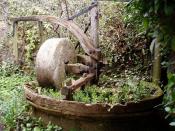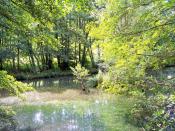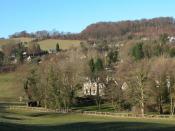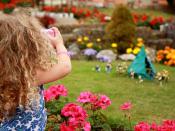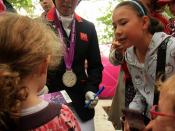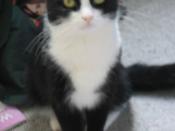Compare The Elementary School In Hard Times By Charles Dickens With The Village School In Cider With Rosie By Laurie Lee Hard times by Charles Dickens and Cider With Rosie by Laurie Lee both portray accounts of the period in which they are set. Hard Times published in 1854ad shows a typical school in Victorian Britain and Cider With Rosie shows a typical rural school in the 1930?s. It soon becomes evident that both schools had many similarities, but they also illustrate a number of differences. During the period of time between the books a significant new law was passed called Fosters Educational Act, (applied in the 1870?s) it meant that attendance at school was compulsory up to the age of fourteen. Both books are set in very different environments with some similarities, but a lot of differences.
Hard Times and Cider With Rosie have some similarities such as they are both typical elementary schools (in their time) and they are both situated in isolated towns/villages.
Hard Times is fictitious, as in Charles Dickens writes about what he thinks is a typical 19th century town. He names the town, Coketown; it is a dirty and polluted town, quite like a normal Victorian town at that time.
? It was a town of red brick, that would have been red if the smoke and ash had allowed it.? Coketown was an industrial town as the industrial revolution had just taken place and a lot of new factories and mills had been built.
? It had a slack canal in it, and a river that ran purple with an ill-smelling dye.? Coketown was a very isolated town, you could say it was in a world of it?s own.
Cider With Rosie Is A semi-autobiography of Laurie Lee?s life. The village he describes is much like Coketown as in it is cut- off from the outside world.
?Living there was like living in a bean pod.? The village is in a self-contained community. without needs from other towns or cities. The villagers worked for either the squire, on farms, or in cloth mills, all other supplies which weren?t available were either supplied by a church, a chapel, a vicarage, a manse, a wooden hut, a pub or the village school.
Laurie Lee describes his first day at school; it comes as a complete surprise to him at the age of four. At first he doesn?t want to go to school, but is forced to by his sisters.
?Boys who don?t go to school get put into boxes, and turned into rabbits, and get chopped up somedays.? His first school experience was when he was bullied.
? I was encircled; grit flew in my face like shrapnel. Tall girls with frizzled hair, and huge boys with sharp elbows, began to prod me with hideous interest. They plucked my scarves, spun me round like a top, screwed my nose and stole my potato.? Eventually a sixteen-year-old junior teacher rescued him, she boxed a few ears and took him to where he should have been, the infants room.
Laurie Lee also tries to incorporate some humour in his book.
?What?s the matter Lol? Didn?t you like it then?? ?They never gave me present!? ?Present? What present?? ? They did! They said: you?re Laurie Lee ain?t you? Well, just sit there for the present.
After a while though Laurie Lee becomes to feel more of a veteran than a new pupil.
Hard Times illustrates a little girls first day at school, her name is Sissy Jupe. Sissy Jupe finds her first day at school intimidating, not because of her fellow pupils, but because of the school inspector Thomas Gradgrind. Thomas Gradgrind refers to her as girl number twenty and insists that she calls herself Cecilia and not Sissy. He asks her what her dad does for a living and she tells him that he is a horse rider (in the circus), he tells her that her dad isn?t a horse rider, but a horse breaker. She also mentions the ?ring? but he tells her that she mustn?t mention the ?ring? in school. He then asks her for the definition of a horse, she is thrown into the greatest alarm by this demand. After a few minutes he announces to the whole class that girl number twenty is unable to define a horse, he then asks for another girls description of a horse and she gives the scientific/dictionary meaning of a horse off the top of her head.
The school in Hard Times only had one room and one teacher called Mr Choakumchild. The schoolroom sounds very dull and boring. There are no pictures, decorations or wallpaper and even the windows are positioned so they don?t let in much sunlight.
?The scene was a plain, bare, monotonous vault of a schoolroom.? The room was segregated with the boys on one half of the room and the girls on the other half of the room, with a teacher at the front. I get the feeling that this room has kind of an aura/a feeling to it and that it is very mind numbing. The schoolroom seems to sound very unnatural with not much light entering the room except for one ray of light, which fell on the most natural pupil in the room, Sissy Jupe.
The school building in Cider With Rosie was a small stone barn. It was partitioned into two smaller rooms with ?the infants? in one room and ?the big ones? in the other room.
? It was a small stone barn divided by a wooden partition into two rooms.? Laurie Lee doesn?t give much of a description of the two rooms, but he mentions the stove in the ?big boys? room.
?The stove was a symbol of caste among us, the tub of warmth to which we cleaved during the long seven months of winter.? The schoolroom in Cider With Rosie seems to sound quite natural and cosy compared to the schoolroom in Hard Times and there seems to be a normal amount of natural night entering the schoolroom as well.
The educational philosophy in Hard Times was to teach as many pupils in the most efficient way and this way was by ROTE method and no other method. The pupils were considered to be: - ? The inclined plane of little vessels then and their arranged in order, ready to brave imperial cannons of facts poured into them until they were full to the brim.? A good example of this is when Bitsa describes a horse.
?Quadruped, gramnivorous, forty teeth, namely twenty four grinders, four eye-teeth, and twelve incisive. Sheds coat in Spring; in marshy countries, sheds hoofs, too. Hoofs hard, but requiring to be shod with iron. Age known by marks in mouth.? Charles Dickens describes how facts are being pumped into the children, because he disagrees with the methods of teaching used in typical Victorian schools. The pupils at this school seem as though they have had all their imagination taken out of them, which has been replaced by facts. The pupils were taught in this way, so they didn?t think for themselves, they learnt just enough to work. Mr Gradgrind pays for the school out of his own pocket and he is generous, but it is he who decides to teach the pupils in this way, the same as many other pupils who were taught in other Victorian school?s at that period of time.
The teaching methods used in Cider With Rosie, especially used on older pupils was also the ROTE method. An example of this is when the pupils revise the units of measurements for both weight and length: - ? Twelve-inches-one foot. Three- feet- make- a- yard. Fourteen- pounds- make- a- stone. Eight- stone- a- hundred- weight.? However pupils were introduced to a cross section of subjects and were encouraged to use their imaginations.
? We sang in sweet choirs, and drew like cavemen, but most other faculties escaped us. Apart from poetry, of course which gave no trouble at all.? The school in Cider With Rosie seems to have some quite good teaching methods, (depending on which teacher taught the pupils) as this school at least tried to develop the pupils imagination and creativity, where as the school in Hard Times has awful teaching methods, with students learning nothing but facts. In both books education is important, they are lower class students, but some pupils may go onto higher education, not because of the teaching methods but because they are naturally intelligent.
There was only one teacher in Hard Times, his name was Mr Choakumchild. His name suggests that he is going to choke the children with factual information. Laurie Lee seems to think that Mr Choakumchild has learnt too much in the way of facts to teach properly ? If he had only learnt a little less how infinitely he might have taught more.? There was also another teacher mentioned in Hard Times his name was Mr Gradgrind. He was the wealthy factory owner, inspector and owner of the school.
There were three teachers in Cider With Rosie, a teacher who taught the ?little ones? and a teacher who taught the ?big ones? and also a sixteen-year-old junior teacher. The ?little ones? teacher was an opulent widow, ?She was tall, and smelt like a cartload of lavender; and wore a hairnet, which I thought was a wig.? The ?big ones? teacher was called Miss B, she was the headmistress of the school. Laurie Lee described her as being as physically smoothing as a rake! ? She was a bunched and punitive little body and the school had christened her ?Crabby;? she had a sour yellow look and lank hair coiled in earphones, and the skin and voice of a turkey.? You could say Laurie Lee was afraid of ?Crabby.? ? She spied, she pried, she crouched, she crept, she pounced- she was a terror.? After a while though ?Crabby? gave up teaching and a new headmistress was replaced in ?Crabbies? place, her name was Mrs Wardley. Mrs Wardley introduced a range of subjects to the children including singing, poetry and bird watching.
?She was fond of singing and she was fond of birds, and she encouraged us in the study of both.? I think Laurie Lee liked Mrs Wardley, well he didn?t love her but I think he liked her compared to ?Crabby? We are introduced to very few pupils in Hard Times, but Dickens provides us with a contrast between Sissy Jupe and Bitza. Bitza was a typical product of Thomas Gradgrind this is a description of what Bitsa looked like: - ? His skin was so unwholesomely deficient in the natural tinge, that he looked as though, if he was cut he would bleed white.? Sissy Jupe was a normal child and by attending this school it was as though she was going to have all her naturalness drained away and replaced by facts. Bitsa had been turned into an unnatural child and this is how Sissy Jupe would probably end up being like eventually.
The pupils in Cider With Rosie were natural, they behaved as we would expect children to behave. Many of the pupils attempted to find ways of skiving and at playtimes they played games.
?Once when some tests hung over our heads, a group of us boys evaded them entirely by stinging our hands with horseflies. The task took all day, but the results were spectacular, our hands swelled like elephants trunks.? The different pupils reacted differently to different situations they faced in their school life. Laurie Lee?s reaction to his first day at school was hated, his sisters forced him to go, but in the end I think he relished school life.
There are many similarities, but also some striking contrasts between the elementary school in Hard Times and the village school in Cider With Rosie. Children were specially educated for work in both schools and ROTE learning was evident. The pupils in Cider With Rosie had their imaginations developed although it depended on the teacher. In Hard Times the pupils were taught with no emotion or imagination, just pure and solemn facts. The pupils in Hard Times had a desire to learn, education was a privilege, where as the pupils in Cider With Rosie had no choice as Fosters Education Act (compulsory education up to the age of fifteen) had been introduced in the 1930?s. Charles Dickens, Hard Times was a social comment on a typical Victorian school where as Laurie Lee?s, Cider With Rosie is semi-autobiographical.
